Rear Side Door Outer Panel Replacement
| Rear Side Door Outer Panel Replacement |
Special Tools
| • |
BO-6396
Bending Pliers
|
|
| • |
BO-6392
Flanging Tool Kit
|
|
| • |
BO-6392-1
Flanging Tool Kit
|
|
| • |
BO-6392-2
Flanging Tool Kit
|
|
| • |
BO-6392-4
Flanging Tool Kit
|
|
| Mode of Procedure for Removal |
As a matter of principle, it is necessary to remove the component, on which the outer skin is to be replaced, from the vehicle and to remove any attaching parts present (on rear end doors this includes windows attached with adhesive).
Normally, only a specific part of an outer skin is replaced (upper or lower half). A joining point is given for this near the window line.
Adhesive bonds between the outer skin and the inner frame are cut with flat scrapers or glass removal tools.
Spot welds are drilled out in the conventional way.
Two possibilities are available for the removal of outer skins with folded edges:
| Method | Tool | Area of Application |
|
Chiselling off
|
Folded edge toolkit BO-6392
|
On straight or slightly curved folded joints
|
|
Grinding through
|
Grinding disc
|
On straight and angled folded joints
|
Mode of Procedure with BO-6392
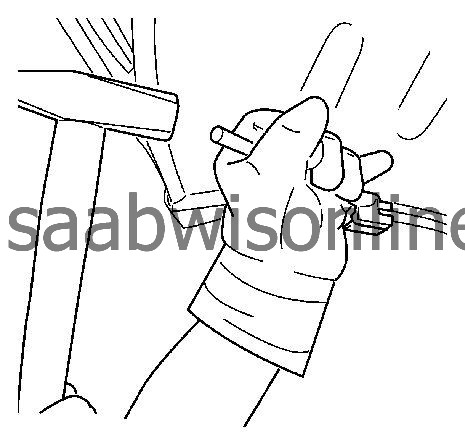
The chisels BO-6392-1 flanging tool kit and BO-6392-2 flanging tool kit should only be used manually as a matter of principle and not in a compressed air chisel.
It is necessary to remove the seam sealant to reach the raised seam more effectively.
The blade of the BO-6392-1 flanging tool kit (or BO-6392-2 flanging tool kit ) is pressed under the flanged folded joint with a suitable hammer. The outer plastic jaw serves as a guide and should be run along the outside on the edge of the component.
The blade opens the folded edge joint if the user hammers evenly on the handle of the chisel.
The opened edge can then be opened up completely with a pair of pliers and the outer skin removed from the frame.
Mode of Procedure with Grinding Disc
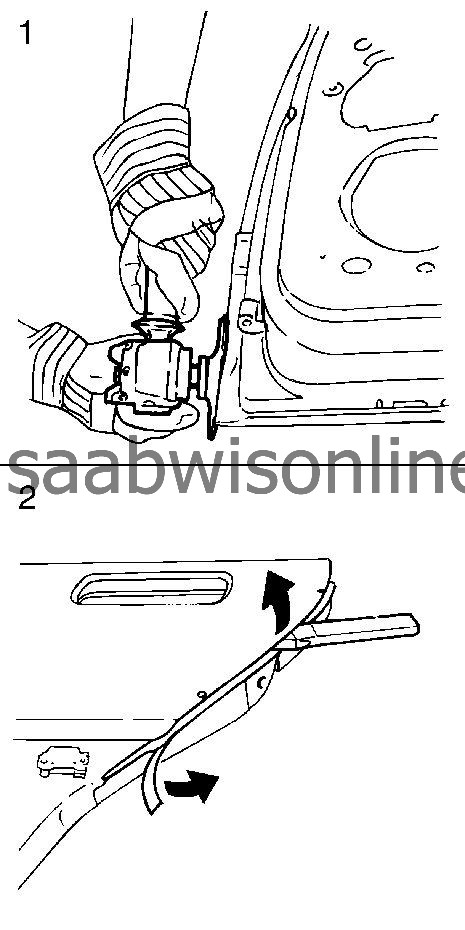
| Note | ||
|
Do not damage the sheet metal lying in the folded edge joint. |
Use an angle grinder with a grinding or toothed grinding disc.
Cut through edge of component slowly and carefully applying a low level of pressure evenly (1).
A sufficient cutting depth has been reached when individual layers of sheet metal become visible on the cut open edge.
Cut the individual layers of sheet metal with a flat chisel and remove from the framework (2).
| Mode of Procedure for Installation |
Remove residual sealant from panel frame. Grind welding flanges on panel frame and new part down to bright metal. Cut down beads of adhesive from inner framework to outer skin. Straighten panel frame if necessary. Grind residues of spot welds smooth. If necessary, work in dividing point between new part and outer skin.
Applying 1-Component Glass Adhesive
Clean surfaces of new component to be bonded using the cleaning material from the kit, apply primer and allow to air dry.Apply 1-component glass adhesive to cut down beads of adhesive
Applying 2-Component Body Structural Adhesive (93 160 535 / 15 05 000)

| Note | ||
|
Only use the adhesive cartridge in a suitable cartridge gun. |
| Note | ||
|
Leave at least 40 mm free in adhesive zones within the connection area of any MIG-brazed seams which may be present. |
Clean the flanges to be bonded on the new component and the frame with the cleaning material from the kit.
Lay a test bead (approximately 20 cm long), until the adhesive is evenly mixed through.
Apply a bead of adhesive (1) around the circumference of folded edge joint and welding flanges.
Aligning the New Outer Skin Component
| Note | ||
|
To prevent indentations, place an underlay between the locking pliers and the new outer skin component. |
Lay new part on frame and align. Fix, e.g. with locking pliers. Fit component on vehicle and align outer skin. Then remove component from vehicle again.
Several possibilities exist for making the folded edge joint on the new outer skin.
| Method | Tool | Area of Application |
|
Pre-prepare the folded edge seam
|
Hammer-headed chisel BO-6392-4
|
Straight, flat, slightly arched folded edge folded joint
|
|
Close fold
|
Folded joint pliers BO-6396
|
Only flat, unarched folded joints
|
|
Entire folded joint and align subsequently
|
Hammer and pad
|
All folded edge joints
|
Pre-prepare joint with hammer-headed chisel BO-6392-4
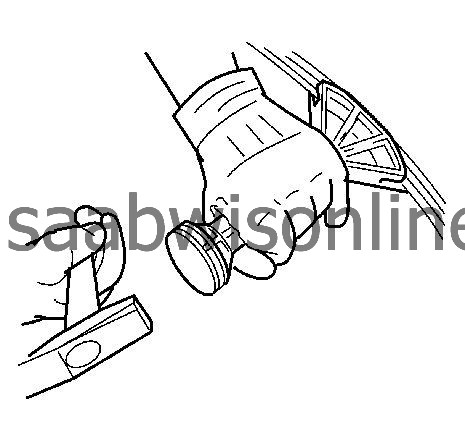
| Note | ||
|
Do not tilt hammer-headed chisel to avoid damage. |
Position hammer-headed chisel BO-6392-4 flanging tool kit and bend folded edge joint evenly around the circumference within the working area provided by striking the handle with a hammer.
Close fold with folded joint pliers BO-6396
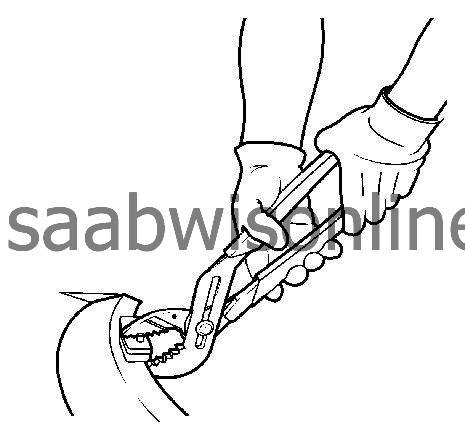
| Note | ||
|
Do not tilt folded joint pliers to avoid damage to the outer skin. |
Position folded joint pliers BO-6396 bending pliers with the inner working jaw on the outer skin. Close partially bent folded edge joint by pressing closed with the folded joint pliers completely and evenly around the edge.
Course of fold with hammer and pad
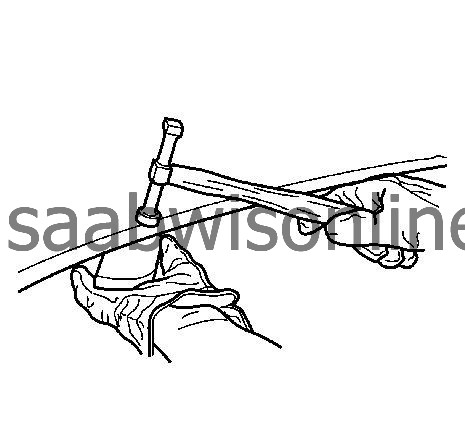
Pre-fold folded flange with a suitable hammer whilst simultaneously counterholding with a pad or block.
Complete folding of folded flange around the circumference with hammer and block.
Resistance Spot Welding
| Note | ||
|
In the edge area, the outer skin is only butt spot-welded from behind in some places along the fold. |
Position spot welds as on old part.
MIG-Brazing Butt Welds
MIG-braze joints when replacing tailgate outer skins and grind down.Aligning Folded Joint
Align and smooth flanged folded joint and outer skin with hammer and block. If necessary, finish outer skin with body file to produce a surface suitable for applying paint.Sealing Folded Joint and Assembly
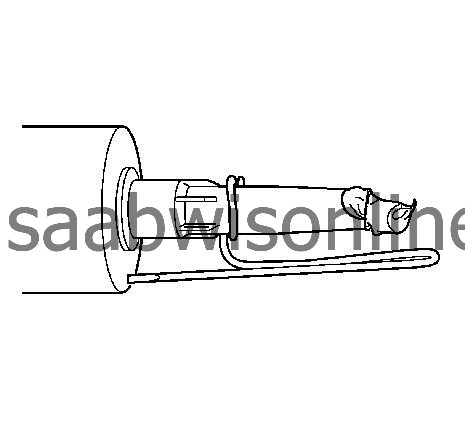
| Note | ||
|
Comply with air-drying time for primer. |
| Note | ||
|
Apply the seam sealant as evenly as is undertaken in the works. Only brush in the corner areas. |
Paint on surface adhesive with a spatula or flat paintbrush as a seam sealant and corrosion protection and allow to cure.
Prime folded joint
Apply body sealing compound around the circumference of the folded edge. If necessary cut tip of cartridge to size and make a spacer from wire to guide the cartridge tip along the edge of the component and attach.
After completion of painting, fit attaching parts and apply corrosion protection wax in the cavities.


